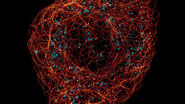Wang, L. et al.:
A general strategy to develop cell permeable and fluorogenic probes for multicolour nanoscopy
Nature Chemistry volume 12, pages 165–172 (2020)
Researchers at the Max Planck Institute for Medical Research in Heidelberg have developed a general strategy to synthesize live-cell compatible fluorogenic probes, and the result are the new MaP (Max Planck) probes. By introducing a smart chemical modification, the equilibrium shifts towards the “closed” form and maximizes cell permeability and with minimal background, and it shifts back to the fluorescent “open” form upon binding to the target of interest. The MaP probes are highly fluorogenic, showing an increase in fluorescence up to 1000-fold, and allow straightforward imaging without the need of any washing steps. The design principle, first tested on 6-TAMRA, produced probes with spectral properties spanning the entire spectrum of the visible light and suitable for live-cell imaging of proteins associated with cytoskeleton, mitochondria, and nuclei with confocal as well as STED super-resolution microscopy.
The study, conducted by Lu Wang during his postdoc at the Max Planck Institute’s Department of Chemical Biology, directed by Kai Johnsson, was published in Nature Chemistry.





